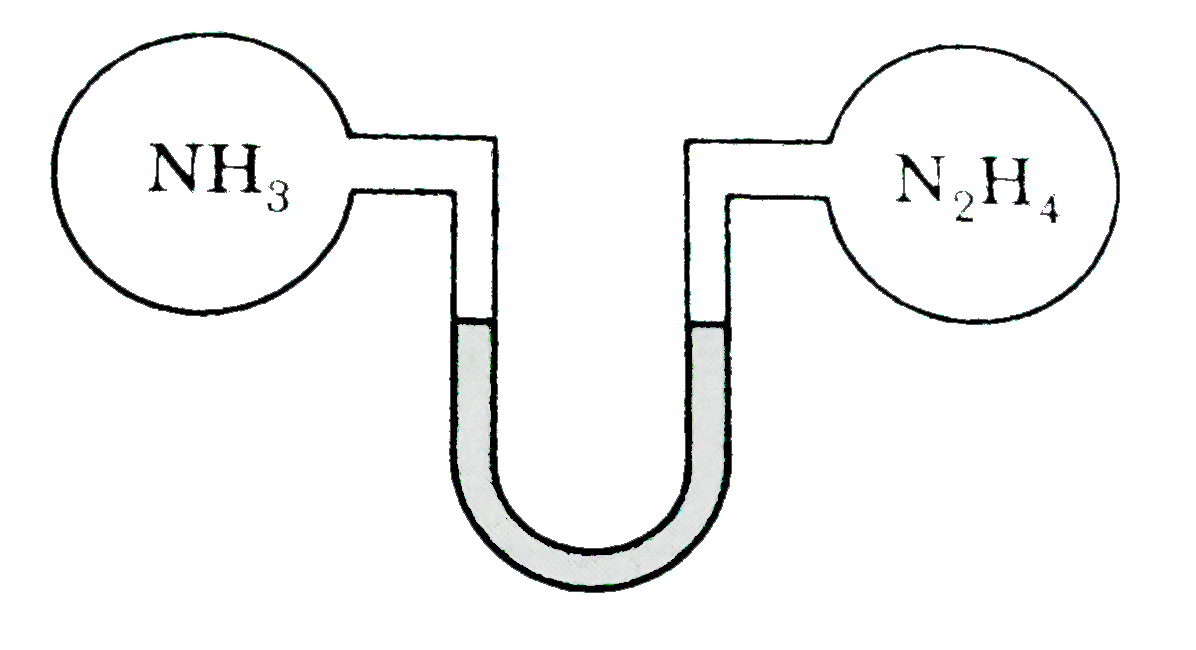Figure shows a manometer, one arm is connected with a bulb containing NH3 and other arm containing N2H4 both at initial pressure of 1 atm. Initially both arms of manometer contains liquid at same level, what will be difference in level of arms, when 50% NH3(g) and 75% N2H4(g) dissociates according to the given reaction. Assume temperature remains constant?

2NH3(g)→N2(g)+3H2(g)
N2H4(g)→N2(g)+2H2(g)
76 cm if liquid having density 13.6 g/mL is used
38 cm if liquid having density 27.2 g/mL is used
152 cm if liquid having density 6.8g/mL is used
304 cm if liquid having density 3.4g/mL is used
The correct Answer is:abcd
Step by step video, text & image solution for Figure shows a manometer, one arm is connected with a bulb containing NH_(3) and other arm containing N_(2)H_(4) both at initial pressure of 1 atm. Initially both arms of manometer contains liquid at same level, what will be difference in level of arms, when 50% NH_(3)(g) and 75% N_(2)H_(4)(g) dissociates according to the given reaction. Assume temperature remains constant? 2NH_(3)(g)rarrN_(2)(g)+3H_(2)(g) N_(2)H_(4)(g)rarrN_(2)(g)+2H_(2)(g) by Chemistry experts to help you in doubts & scoring excellent marks in Class 11 exams.
Topper's Solved these Questions
Similar Questions
Knowledge Check
- Question 1 - Select One
For the reaction
2NH3(g)⇔N2(g)+3H2(g) the units of Kp will beAatmB(atm)3C(atm)−2D(atm)2 - Question 2 - Select One
At constant pressure, the addition of argon to N2(g)+3H2(g)→2NH3(g)
AReduces the formation of ammonia from nitrogen and hydrogenBIncreases the formation of ammonia from nitrogen and hydrogenCDoes not effect the equilibrium of the reaction in which ammonia is formed from nitrogen and dasanDReuces the dissociation of ammonia - Question 3 - Select One
KC for the reaction 12N2(g)+32H2(g)⇔NH3(g) is
AKc=[NH3][N2][H2]BKc=[N2][H2][NH3]CKc=[NH3][N2]12[H2]32DKc=[N2]12[H2]32[NH3]
For the reaction
N2(g)+3H2(g)⇔2NH3(g),ΔH=?View SolutionΔCp for the change, N2(g)+3H2(g)=2NH3(g) is
View SolutionWhich of the following is correct for the reaction?
N2(g)+3H2(g)⇔2NH3(g)View SolutionWhich of the following is correct for the reaction?
N2(g)+3H2(g)⇔2NH3(g)View SolutionΔCp for change ,N2(g)+3H2(g)=2NH3(g) is :
View Solution


